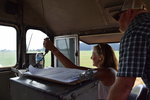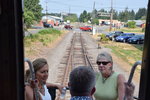


Two local lawmakers got a chance to be a train engineer during an Aug. 8 excursion on the Chelatchie Prairie Railroad where the economic opportunities along the short line rail were put on display.
Clark County Councilor Julie Olson and Washington State Sen. Lynda Wilson, both Republicans, joined representatives of Portland Vancouver Junction Railroad (PVJR), the operators of the county-owned Chelatchie Prairie, for a train ride along a stretch of the rail being looked at for industrial development. Wilson introduced ESB 5517 in 2017, a bill which allows for that type of development along short lines in Clark and Okanogan counties, and following its passage Olson and other members of Clark County Council have been working on how that legislation will look in terms of its implementation locally.
The lawmakers and PVJR officials met nearby Battle Ground School District’s Center for Agriculture, Science, and Environmental Education before hopping on a train engine, first heading south to just north of 119th Street before going in the opposite direction into Brush Prairie, crossing Route 503 in the process. The trip was on a single engine, not a long train packed with cargo, and offered a glimpse of what exists along the line in some cases far from what’s visible from the road.
Wilson said that actually seeing the course of the rail line helped to get a better understanding of what an economic overhaul of the area would look like as opposed to just looking at a map. She added that successful implementation of the bill would also prove that the type of work it allows could be done across the state, not just in Clark and Okanogan counties.
Amber Carter, a lobbyist for PVJR, said of the two counties Clark stood out because of data gathered by the Columbia River Economic Development Council. The rail line has already generated interest, with the trip passing by some acreage commonly referred to as the Lagler property to the West of the tracks. Though he didn’t give a name of the company, PVJR President Eric Temple said that one possible industry looking at the area was in the aggregate materials construction business.
That potential industry has also looked at the possibility of asphalt manufacturing along the line, which Temple noted had been a point of interest for those following the development. Temple assuaged fears of allowing an asphalt plant to move in, explaining that a modern facility would have almost zero emissions.
“There’s no substitute for asphalt at this point. We are going to use it. The only question is if it’s in the most modern, most environmentally-friendly facility and creating local jobs, or whether we are exporting it maybe a little further away to an older facility and maybe putting the jobs in Oregon,” Temple said.
On some parts of the trip the railroad came close to residential areas, in some cases cutting across the private drives requiring a few blasts of the train horn to ensure a safe crossing. The impacts development would have on the railroad’s neighbors was taken into account by buffering standards, Olson said.
“We’re not just going to let warehousing and heavy industrial uses go in without making sure we protect the neighbors as well,” Olson said.
Temple mentioned that the county’s Freight Rail Dependent Uses Advisory Committee had gone a step above the current highest level of buffering the county had.
“L-5 (buffering) was the gold standard. We recommended the platinum standard,” Temple remarked. Six-foot earthen berms along the perimeter of the railroad with at least a four-foot additional buffer of mixed evergreen foliage would help to mitigate the effects of a more frequently run railroad.
Should industry come in the current rail line would need some work, but the question on track improvements wasn’t how long it would take but how the funds could be allocated. Temple reasoned the improvements needed would be around $45 million, adding that the eight-figure work would pay for itself over time.
Carter noted that currently Chelatchie Prairie had what was known as “accepted track” — a level below the “lowest” standard classification for rail. For the current traffic in the area, about a trip once a week, it was sufficient — though increased industry would need improved infrastructure to operate optimally.
Funding rail improvements would likely come from multiple sources, most notably grants like the state Freight Rail Assistance Program.
Once that funding comes in, actually making the improvements would take very little time as federal exemptions on the railroad meant work could be started immediately and go fast without lengthy permitting processes slowing things down.
“I could have (the improvements) done in a week if I had the money,” Temple said.
The railroad having more use would alleviate other forms of traffic in the area. Temple estimated that if the construction company did come to the Chelatchie Prairie, only one daily train trip would eliminate 30,000 to 40,000 truck trips on local highways annually .
“That’s the beauty of railroading; it’s the efficiency,” she said.
The trip marked the first time that either Olson or Wilson had driven a train, receiving guidance and occasional help with breaking by PVJR General Manager Nathan Bruce. Both lawmakers had a good time taking up the role of conductor.
“I didn’t even know what to expect, but it was fun,” Olson said.